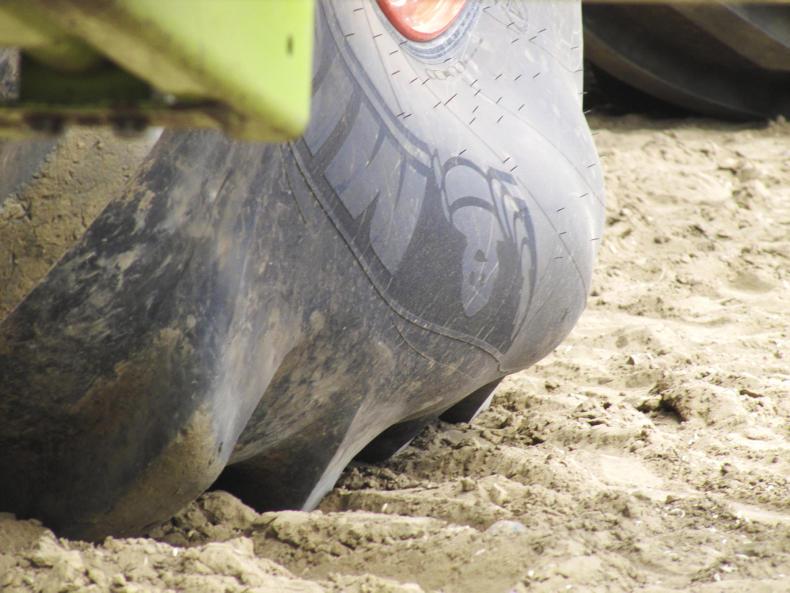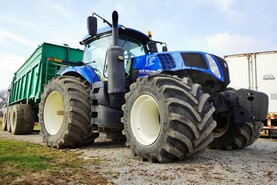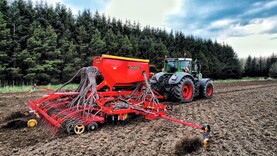Recent spells of wet weather have led to deteriorating ground conditions in many parts of the country. With the harvest well under way and still a sizeable amount of silage to be gathered, it’s vital that soil structure is protected when operating heavy machinery. The misuse of such machinery in wet conditions can cause major trafficability and compaction issues. Wet soil simply cannot support the same weight as dry soil.
Tyres serve two main purposes on agricultural equipment. They transmit power, delivering traction, and carry and distribute the load of the machine on the soil. Aside from their obvious functions, tyres contribute to machine stability, steering and suspension.
Advancing technology
Tyres can play a big role in reducing soil compaction. Tyre technology has advanced well in recent years with flexible wall technology allowing for lower operating tyre pressures. This technology was pioneered by Michelin over a decade ago, delivering greater scope for reducing ground pressure.
Designing tyre carcases that are capable of running at a greater level of deflection allows a given size tyre to have a lower inflation pressure. These tyres are denoted by the letters IF (increased flexion) or VF (very high flexion) beside the tyre size figures.

A VF (very high flexion) rated tyre can work at 30% less pressure while carrying the same load as a standard tyre.
This can have a significant impact on the contact patch between the tyre and ground pressure that these tyres exert. Consequently, greater loads can be carried at a given inflation pressure or, for a given sized load, inflation pressure and consequently ground pressure can be reduced.
Michelin now uses this technology in a number of tyre ranges for tractors and combines (Xeobib and Axiobib) and other manufacturers such as Trelleborg, BKT, Mitas, Firestone and Bridgestone have all adopted similar technology over the last few years. The increased flattening of the carcase allows a decrease in ground pressure. Therefore, the lower the tyre pressure the lower the pressure on the soil.

Modern tyre technology permits lower inflation pressures and increased levels of carcase deflection.
Just how much better are they?
IF tyres can carry approximately 20% more load at the same inflation pressure compared to a standard tyre of the same dimensions. On the other hand, they can carry the same load as a standard tyre but at about 17% lower inflation pressure. The VF-rated tyres allow even more deflection and carry up to 40% more load compared to standard tyres or the possibility of working at 30% lower pressure carrying the same load.
Such technology is especially useful as more contact area is achieved without changing the tyres’ width much. This is particularly useful for applications such as ploughing or keeping machines within a certain working width.
Combines are a good example of this as farmers/contractors have now the option of fitting a VF tyre over an expensive track unit while achieving equally good results in terms of minimising soil compaction.
A fully ballasted 160hp tractor would have a typical axle load in the region of 8t pulling a large trailer or slurry tanker imposing a 4t hitch load.
Table 1 shows the benefits of using IF and VF tyre options. The suitable inflation pressures and ground pressure of each tyre are shown.
Although it may not may not seem possible, but by just choosing a VF tyre, a 650/65 R38 for example, it will allow a lower inflation and in turn a reduced ground pressure over an 800mm or 900mm standard tyre. This just shows the benefits of such technology.
Selecting tyres and the ground pressures needed
To determine the correct size tyres for a particular situation, the following five steps are useful:
1 Determine the target ground pressure/inflation pressure.
2 Measure/estimate your axle load.
3 Consider tyre diameter limitations such as mudguard clearance and 4WD ratio.
4 Search for tyres that will carry the measured load using manufacturers’ load and inflation tables.
5 Consider opting for tyre technologies such as VF or IF.
The required ground pressure depends entirely on soil conditions. Soils that are wet and/or cultivated are weaker and therefore require a lower ground pressure to avoid damage. Table 2 shows some broad guidelines worth considering as rule of thumb.
Tips for challenging conditions
Reduce machinery weight: Where possible, try and reduce the weight of the machinery needed or, if possible, leave the heavier larger equipment in the yard. Instead take out the smaller lighter threading machines. Any non-essential weights should be removed, ie loaders, ballast weights, etc.Reduce ground pressure: Reduce tyre pressures to the minimum recommended for the load in question. This increases tyre contact area with the soil and therefore distributes the load better. When fitting new tyres, choose a tyre that is able to carry the desired load at a low inflation pressure. These tyres will likely not be the cheapest but are generally worth the investment as soil structure falls less of a victim to damage.
The red trailer on the left is fitted with 500/60R22.5 floatation tyres while the trailer on the right is fitted with 385/65R22.5 super singles.
Flotation tyres: Although fitted on most modern machinery, if possible, use only machines fitted with flotation tyres or fit the necessary equipment with flotation tyres if possible. Given that they are not as popular as they used to be, super-single tyres are still used on silage/grain trailers, etc. These tyres have not been developed for low ground pressures, and therefore can cause untold harm especially when field conditions begin to deteriorate. Wet soils cannot support the same weight as dry soils which leads to machinery sinking, causing long-lasting effects to the soil structure. Larger-diameter tyres are a benefit in wet conditions too as they will keep turning out of any rut formed, rather than stopping rotating and dragging. This naturally increases the pull on the tractor and creates further damage. Avoid wet conditions where possible: Where possible, try to avoid working in wet conditions unless absolutely necessary. Damage can be greatly reduced if land is given some time to soak and dry out. Forward planning: Where possible, try to plan field operations carefully and wisely, minimising the amount of travel within each field. For example, try to fill trailers so that when their load increases, the distance to the gap decreases. If a trailer is almost full on approach to the gap, let it go and empty to reduce traffic. Fill the wetter areas empty if possible. Finally, be patient, both common sense and patience can be among the best tips to ensure all goes to plan.
Recent spells of wet weather have led to deteriorating ground conditions in many parts of the country. With the harvest well under way and still a sizeable amount of silage to be gathered, it’s vital that soil structure is protected when operating heavy machinery. The misuse of such machinery in wet conditions can cause major trafficability and compaction issues. Wet soil simply cannot support the same weight as dry soil.
Tyres serve two main purposes on agricultural equipment. They transmit power, delivering traction, and carry and distribute the load of the machine on the soil. Aside from their obvious functions, tyres contribute to machine stability, steering and suspension.
Advancing technology
Tyres can play a big role in reducing soil compaction. Tyre technology has advanced well in recent years with flexible wall technology allowing for lower operating tyre pressures. This technology was pioneered by Michelin over a decade ago, delivering greater scope for reducing ground pressure.
Designing tyre carcases that are capable of running at a greater level of deflection allows a given size tyre to have a lower inflation pressure. These tyres are denoted by the letters IF (increased flexion) or VF (very high flexion) beside the tyre size figures.

A VF (very high flexion) rated tyre can work at 30% less pressure while carrying the same load as a standard tyre.
This can have a significant impact on the contact patch between the tyre and ground pressure that these tyres exert. Consequently, greater loads can be carried at a given inflation pressure or, for a given sized load, inflation pressure and consequently ground pressure can be reduced.
Michelin now uses this technology in a number of tyre ranges for tractors and combines (Xeobib and Axiobib) and other manufacturers such as Trelleborg, BKT, Mitas, Firestone and Bridgestone have all adopted similar technology over the last few years. The increased flattening of the carcase allows a decrease in ground pressure. Therefore, the lower the tyre pressure the lower the pressure on the soil.

Modern tyre technology permits lower inflation pressures and increased levels of carcase deflection.
Just how much better are they?
IF tyres can carry approximately 20% more load at the same inflation pressure compared to a standard tyre of the same dimensions. On the other hand, they can carry the same load as a standard tyre but at about 17% lower inflation pressure. The VF-rated tyres allow even more deflection and carry up to 40% more load compared to standard tyres or the possibility of working at 30% lower pressure carrying the same load.
Such technology is especially useful as more contact area is achieved without changing the tyres’ width much. This is particularly useful for applications such as ploughing or keeping machines within a certain working width.
Combines are a good example of this as farmers/contractors have now the option of fitting a VF tyre over an expensive track unit while achieving equally good results in terms of minimising soil compaction.
A fully ballasted 160hp tractor would have a typical axle load in the region of 8t pulling a large trailer or slurry tanker imposing a 4t hitch load.
Table 1 shows the benefits of using IF and VF tyre options. The suitable inflation pressures and ground pressure of each tyre are shown.
Although it may not may not seem possible, but by just choosing a VF tyre, a 650/65 R38 for example, it will allow a lower inflation and in turn a reduced ground pressure over an 800mm or 900mm standard tyre. This just shows the benefits of such technology.
Selecting tyres and the ground pressures needed
To determine the correct size tyres for a particular situation, the following five steps are useful:
1 Determine the target ground pressure/inflation pressure.
2 Measure/estimate your axle load.
3 Consider tyre diameter limitations such as mudguard clearance and 4WD ratio.
4 Search for tyres that will carry the measured load using manufacturers’ load and inflation tables.
5 Consider opting for tyre technologies such as VF or IF.
The required ground pressure depends entirely on soil conditions. Soils that are wet and/or cultivated are weaker and therefore require a lower ground pressure to avoid damage. Table 2 shows some broad guidelines worth considering as rule of thumb.
Tips for challenging conditions
Reduce machinery weight: Where possible, try and reduce the weight of the machinery needed or, if possible, leave the heavier larger equipment in the yard. Instead take out the smaller lighter threading machines. Any non-essential weights should be removed, ie loaders, ballast weights, etc.Reduce ground pressure: Reduce tyre pressures to the minimum recommended for the load in question. This increases tyre contact area with the soil and therefore distributes the load better. When fitting new tyres, choose a tyre that is able to carry the desired load at a low inflation pressure. These tyres will likely not be the cheapest but are generally worth the investment as soil structure falls less of a victim to damage.
The red trailer on the left is fitted with 500/60R22.5 floatation tyres while the trailer on the right is fitted with 385/65R22.5 super singles.
Flotation tyres: Although fitted on most modern machinery, if possible, use only machines fitted with flotation tyres or fit the necessary equipment with flotation tyres if possible. Given that they are not as popular as they used to be, super-single tyres are still used on silage/grain trailers, etc. These tyres have not been developed for low ground pressures, and therefore can cause untold harm especially when field conditions begin to deteriorate. Wet soils cannot support the same weight as dry soils which leads to machinery sinking, causing long-lasting effects to the soil structure. Larger-diameter tyres are a benefit in wet conditions too as they will keep turning out of any rut formed, rather than stopping rotating and dragging. This naturally increases the pull on the tractor and creates further damage. Avoid wet conditions where possible: Where possible, try to avoid working in wet conditions unless absolutely necessary. Damage can be greatly reduced if land is given some time to soak and dry out. Forward planning: Where possible, try to plan field operations carefully and wisely, minimising the amount of travel within each field. For example, try to fill trailers so that when their load increases, the distance to the gap decreases. If a trailer is almost full on approach to the gap, let it go and empty to reduce traffic. Fill the wetter areas empty if possible. Finally, be patient, both common sense and patience can be among the best tips to ensure all goes to plan. 








 This is a subscriber-only article
This is a subscriber-only article










SHARING OPTIONS: